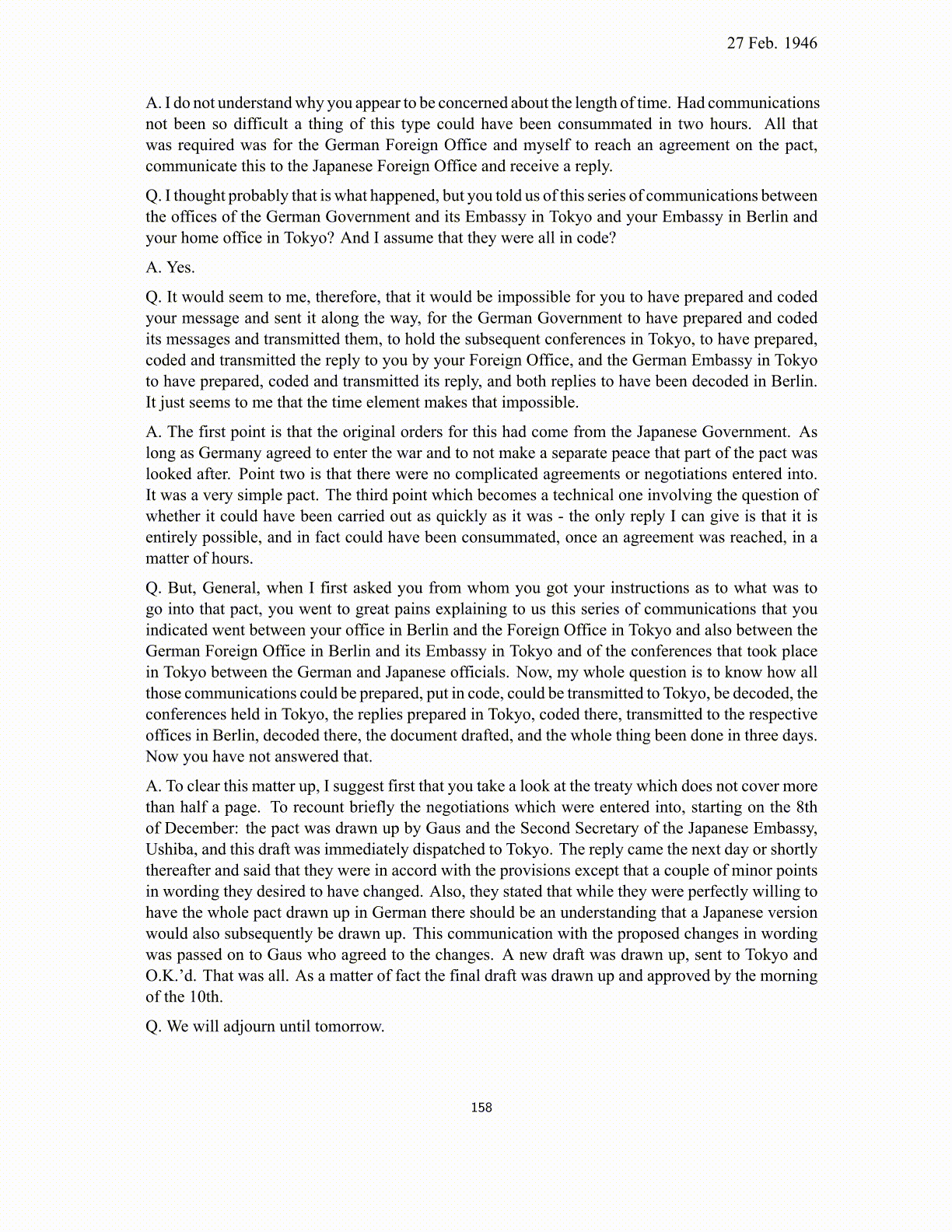
27 Feb. 1946 A. I do not understand why you appear to be concerned about the length of time. Had communications not been so difficult a thing of this type could have been consummated in two hours. All that was required was for the German Foreign Office and myself to reach an agreement on the pact, communicate this to the Japanese Foreign Office and receive a reply. Q. I thought probably that is what happened, but you told us of this series of communications between the offices of the German Government and its Embassy in Tokyo and your Embassy in Berlin and your home office in Tokyo? And I assume that they were all in code? A. Yes. Q. It would seem to me, therefore, that it would be impossible for you to have prepared and coded your message and sent it along the way, for the German Government to have prepared and coded its messages and transmitted them, to hold the subsequent conferences in Tokyo, to have prepared, coded and transmitted the reply to you by your Foreign Office, and the German Embassy in Tokyo to have prepared, coded and transmitted its reply, and both replies to have been decoded in Berlin. It just seems to me that the time element makes that impossible. A. The first point is that the original orders for this had come from the Japanese Government. As long as Germany agreed to enter the war and to not make a separate peace that part of the pact was looked after. Point two is that there were no complicated agreements or negotiations entered into. It was a very simple pact. The third point which becomes a technical one involving the question of whether it could have been carried out as quickly as it was - the only reply I can give is that it is entirely possible, and in fact could have been consummated, once an agreement was reached, in a matter of hours. Q. But, General, when I first asked you from whom you got your instructions as to what was to go into that pact, you went to great pains explaining to us this series of communications that you indicated went between your office in Berlin and the Foreign Office in Tokyo and also between the German Foreign Office in Berlin and its Embassy in Tokyo and of the conferences that took place in Tokyo between the German and Japanese officials. Now, my whole question is to know how all those communications could be prepared, put in code, could be transmitted to Tokyo, be decoded, the conferences held in Tokyo, the replies prepared in Tokyo, coded there, transmitted to the respective offices in Berlin, decoded there, the document drafted, and the whole thing been done in three days. Now you have not answered that. A. To clear this matter up, I suggest first that you take a look at the treaty which does not cover more than half a page. To recount briefly the negotiations which were entered into, starting on the 8th of December: the pact was drawn up by Gaus and the Second Secretary of the Japanese Embassy, Ushiba, and this draft was immediately dispatched to Tokyo. The reply came the next day or shortly thereafter and said that they were in accord with the provisions except that a couple of minor points in wording they desired to have changed. Also, they stated that while they were perfectly willing to have the whole pact drawn up in German there should be an understanding that a Japanese version would also subsequently be drawn up. This communication with the proposed changes in wording was passed on to Gaus who agreed to the changes. A new draft was drawn up, sent to Tokyo and O.K.’d. That was all. As a matter of fact the final draft was drawn up and approved by the morning of the 10th. Q. We will adjourn until tomorrow. 158